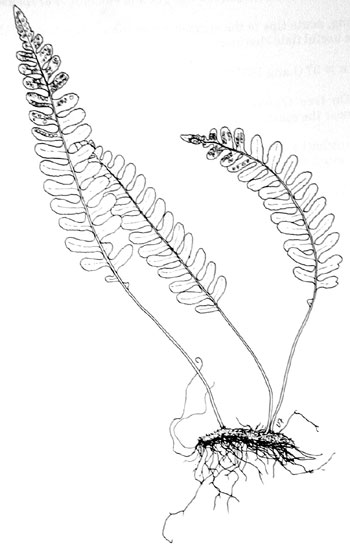|
Hardy Fern Home P. amorphum resources All Ferns � Polypodiaceae �� Polypodium
�Other Genera
|
| Polypodium amorphum | ||
Mountain polypody | ||
|
Etymology
From the Greek word amorpha which translates as shapeless or deformed.
Description
Rhizome: creeping, branching, whitish waxy, rather thick, acrid-tasting, to 6 mm diameter, scales lanceolate, base and margins light brown, sometimes with dark central stripe.
Frond: 50 cm high by 8 cm wide, evergreen, new fronds midsummer, monomorphic, blade/stipe ratio: 2:1. Stipe: jointed at base, straw-colored, narrowly triangular, red-brown scales, to 6 mm, these scales are peltate, vascular bundles: 3 at the base, unifying upwards into an open v-shape. Blade: pinnatifid, distinctly oval, diminishing sides in the lower half, truncated base, arching, somewhat leathery, mid-green, dull in shade, rachis glabrous above, sparsely scaly below, scales lanceolate-ovate. Pinnae: 6 to 12 pair, alternate, longest pinnae at the middle; margins shallowly serrate; veins free, forking. Sori: oval when young (and closer to the rachis), more round later, discrete, less than 3 mm diameter, sunken into the lamina, bulging on the top surface, midway between margin and midrib, on the upper half of the blade, indusium: absent, sporangia: early green, later yellow, then rusty brown; paraphyses present, maturity: summer to fall. Culture
Habitat: cliffs and rocky slopes; usually on igneous substrates.
Distribution: British Columbia to Oregon, disjunct in Wyoming, Colorado.
Hardy to -20�C, USDA Zone 6.
Distinctive Characteristics
The smallest of the western North American polypodies. Most likely to be mistaken for P. hesperium, but round sori here vs. oval in P. hesperium is conclusive; so too is a dark central stripe on the rhizome scales, if present.
Synonyms
Polypodium montense F. A. Lang Compare with other species in the Western North America Group
|
|
|
|
Polypodium amorphum.� Habitat, Snohomish County, Washington. �Robbin Moran |
